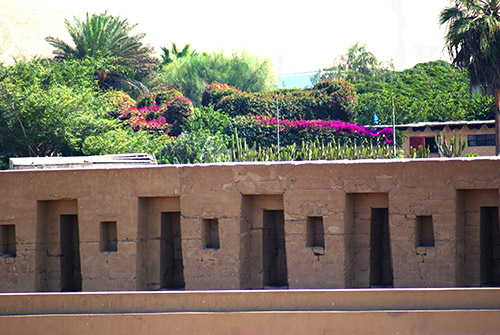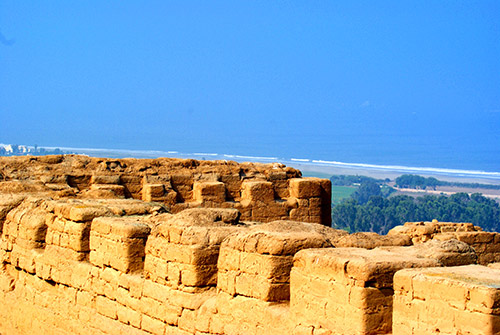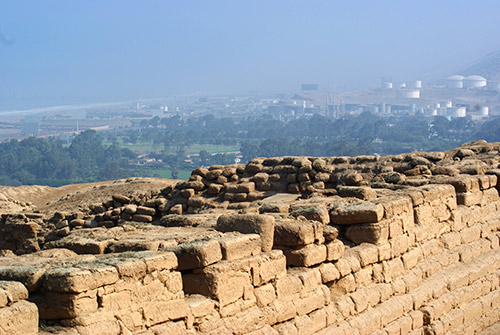Pachacamac Archaeological Center

Pachacamac Archaeological Sanctuary is located in the lower valley of Lurin to the south of Lima at a distance of about 40 km. It is seated atop a rocky projection covered by aeolian sand. It is surrounded on the north and east by the shallow valleys of Lurin on the west and southwest with an area of lakes and wetlands, and on the southeast by the Lurín River.
The ceremonial center of Pachacamac was devoted to the highest deity of the coast of Peru. Thousands of pilgrims flocked to the site to ask for favors and advice from God, who, they believed, spoke through his priests. It was a holy city where every building had a sacred connotation or administrative relevance.
Many buildings were developed across a period of more than 1500 years. These buildings were built by the various societies that settled in the area and each of them have their own characteristic architectural models and construction techniques.

The monumental archaeological site of Pachacamac stretches across an area of 465.32 hectares and has a linear perimeter of 12,925.41 meters. It has been the site of human occupation through the period ranging from 200 AD to 1533 AD, time of the arrival of the Spanish occupation. The oldest temples in Pachacamac are built of hand made adobe bricks. This type of construction was used extensively during this period.
Also found in association with this architecture is a type of ceramic which is characterized by the use of three colors: black-red-white, which is known as "interlocking" style.
The most representative buildings of this period are the Old Temple, the Temple of Urpiwachak, the foundations of the Temple of the Sun and the Painted Temple.
A great number of tombs and funerary architecture of this elite civilization is attributed to this period. The building that presents further evidence of this is the Painted Temple or Temple of Pachacamac, according to Max Uhle (1903).

The Painted Temple
The Painted Temple is built on a stone foundation and adobe brick walls. It has an elongated shape with its front facing the northwest. Its main façade presents a series of terraces with steps depicting naturalistic polychrome designs with plasters and paints.
To enter this temple, there is an upward zigzag path up to a large square-shaped yard. To the southeast of the temple are a series of small rooms with stairs and deposits. In front of the temple and below, there are about a hundred graves, according to the work of Max Uhle (1903), which could correspond to about 30,000 human burials.
Regional Manors (1200 A.D. - 1450 A.D.)
Many pyramidal building construction ramps were built during this period. The proportion and the volumes of these structures indicate an ordering and arrangement of space in fixed patterns, although the orientation of its ramp-axis can vary between the north and east.
The pyramids have square or rectangular shaped yards with one or two ramps that are connected to the pyramidal terraces. Small areas waiting rooms, dormitories and residences. can be observed at the top of the pyramids.
Bricks and mud mortar has been used for the construction of the pyramids. They have also been covered with plaster, but are not painted. There are a set of enclosures, with quadrangular openings that have no access. It's function was to reserve space and tillage areas for pilgrims.

Inca Empire (1450 A.D. - 1533 A.D.)
On arrival of the Incas, two new temples were built: the Temple of the Sun and the Acllahuasi or Mamaconas enclosure.
The Temple of the Sun
The Temple of the Sun has 4 pyramids. The material used for its construction has been adobe brick in various sizes.The base is constructed of quarried slate stones, together with a mud mortar plinth.
The temple has an average height of 20 meters. The most important part of the temple corresponds to the upper terrace, where a variety of compartments for the worship of the Sun have been built. The western front of the structure houses the niches and columns arranged in corridors and passages. The front that contains the main entrance to the temple is in a zigzag structure, with a staircase decorated and painted in red and yellow.
The AcllahuasiThe Acllahuasi is a classical architecture of the Inca period. Its entrance area has a zig-zag form. Moreover, it is equipped with the foundation stones of polished granite. Other Inca buildings
Apart from Acllahuasi and the Sun Temple, the site has other Inca structures such as the Plaza of the Pilgrims and the Ushnu.
Visitwww.mcultura.gob.pe
The Lima Metropolitan Chapter.
Lima: Lima Metropolitan Chapter, 2000. S /. 20.00


